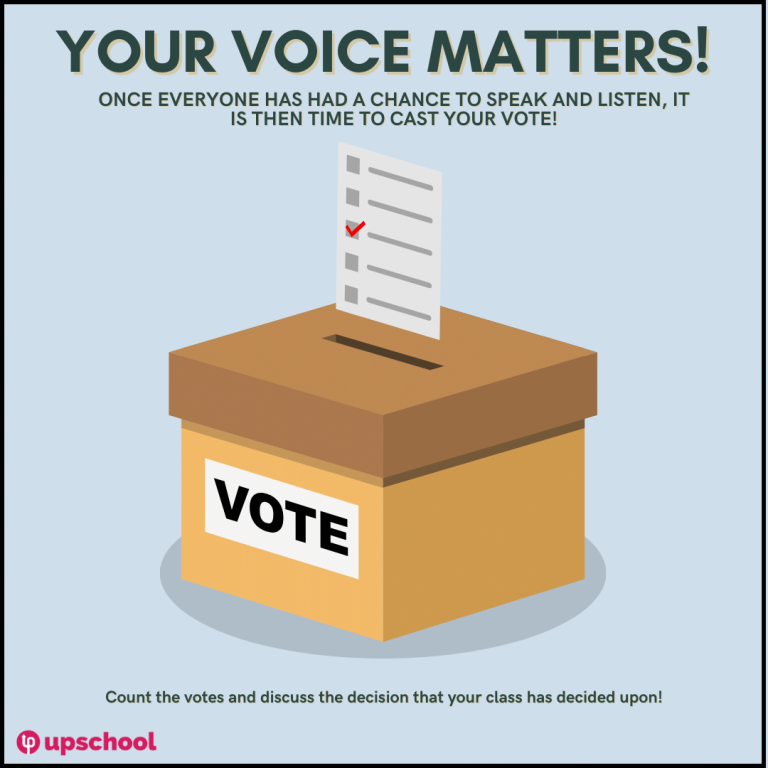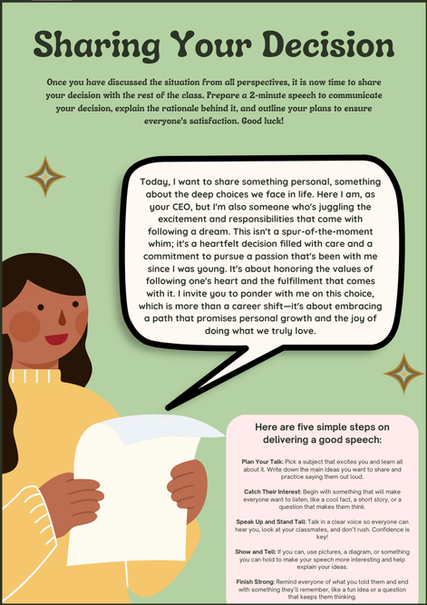Social Scenario 8
Luxury living or Lifelong love?
Introduction
This lesson is designed to engage students in ethical decision-making by stepping into the role of a CEO tasked with a challenging scenario. The focus is to encourage students to employ empathy as a guiding principle while considering the broader consequences of their choices.
You’ll guide the students through a video that outlines a complex situation requiring a decision that has significant implications for various stakeholders. The aim is for students to understand the interconnectedness of decisions within a business context and beyond.
The exercise is structured to cultivate skills such as critical thinking, problem-solving, and collaboration. It’s vital for students to practice active listening, respect diverse viewpoints, and constructively contribute to their team’s discussion.
Throughout the lesson, the emphasis on ethical decision-making should be paramount. Encourage students to identify and weigh the moral components of the decision at hand: Who will be affected? What are the potential positive and negative outcomes? How can empathy lead to a more ethical and fair decision?
This week’s theme is all about ‘Choice’. Picture yourself as the CEO of a big company, where making tough decisions is part of the job. You’ve got to consider all angles and understand how your choices affect everyone.
We’ve got a video to set the scene, so watch it, team up, and figure out what you’d do. Then, share your decision with the class. It’s a chance to see how one choice can touch many lives.
Think about Mr. Jackson, the CEO with a fancy office and everything money can buy. Yet, he often daydreams of a childhood spent caring for animals, not sitting in meetings. His heart’s pulling him towards a life with animals, but he’s got a company and its employees to think about. What should he choose: passion or responsibility?
Quote of the week - Alan Watts
Each week we will start by reading a quote, talking about what it means to further understand how we can use these words as lessons to learn from.
Read the following quote and discuss it with your class. You may even want to print it out and collate the quotes over the weeks to create a wall of discussion for future research projects.
Read this week’s quote and think about what it means and what we can learn from it to make the world a better place!
You may want to note it down in your notebook and draw a nice picture next to it! Each week we will visit a quote from a famous figure in the world and try to read between the lines of what they mean.
Quotes can be very powerful tools for change and a wonderful way to get your message out to the world.
Stick this one on the classroom wall and maybe discuss it each day before you go home from school.

Reading Activity - The Scenario
During today’s lesson, the children will be working on problem-solving and decision-making skills by participating in a group activity. They will be given a social scenario and will have one hour to decide what they think the best option is, then they will share their decision with the rest of the class for a debate.
During this activity, the children will practice their critical thinking skills by considering different perspectives and ideas. They will need to listen to each other, ask questions, and be respectful of different opinions to come up with the best possible solution.
The importance of this lesson is to equip the children with the necessary skills to make decisions that affect themselves and others in their daily lives. By working together and practicing now, they will be better prepared to handle situations that require problem-solving and decision-making in the future.
In this session, we’re honing our problem-solving and decision-making abilities. As a team, we’ll spend an hour dissecting a social issue, aiming to identify the most appropriate solution. Afterward, we’ll present our findings to the class to spark a discussion.
The group effort will enhance our understanding of various viewpoints and push us to apply critical thinking to arrive at the best solution. It’s essential to listen attentively to our peers, inquire thoughtfully, and consider all opinions with respect.
Developing this skill set is crucial; we’re often faced with complex situations that require sound judgment. By practicing in a controlled environment, we’re preparing ourselves to make informed decisions in the real world.
Now, let’s examine the scenario, weigh all perspectives, collaborate effectively, and discover the most compelling approach to this week’s social issue.

Group Analysis - What Do You Think? Let's Discuss.
Students will use the booklet provided to evaluate the impact of a decision on each stakeholder involved. They will work in teams to discuss the positive and negative effects of the decision and take notes on their findings.
The students will then be asked to think about a solution or an alternative to avoid the negative impact on the stakeholders. For example, if the decision made has a negative impact on a stakeholder, the students will need to think about alternative ways to protect them from this danger.
To complete this task, the students will need to use their critical thinking and problem-solving skills. They will need to evaluate the situation from different perspectives and consider the impact of their decision on all stakeholders involved.
Additionally, the students will need to demonstrate effective communication and teamwork skills as they work together to discuss and analyze the situation. They will need to share their ideas and listen to each other’s perspectives to come up with the best solution possible.
Overall, this activity aims to develop the students’ ability to think critically and empathetically, and to encourage them to consider the impact of their decisions on others.
Use the booklet provided to evaluate the impact of the decision on each stakeholder involved. Work with your team to discuss the positive and negative effects of the decision, and take notes on your findings.
Then, based on the impact, think about a solution or alternative to avoid the negative impact on stakeholders. For example, if sitting in the sun for too long can cause skin cancer, wearing sunscreen can help protect us from this hazard.
If the decision made has a negative impact on a stakeholder, consider alternative ways of protecting them from this danger.
Work together and discuss the situation from all perspectives, taking into account the needs and concerns of all stakeholders. Use your critical thinking and problem-solving skills to come up with the best solution possible.
Stand Up and Speak - Your 2 Minute Delivery
Students will follow the task card’s five steps to prepare a two-minute talk. They will decide what to say and who will say it. Students will also need to be prepared for questions that may arise during or after the presentation.
During the talk, students will explain their decision and its impact on everyone involved. It’s essential to speak clearly and use simple language to ensure that everyone understands. This will also help to ensure that everyone is on the same page and there is no confusion about the decision made.
Preparing for this talk is an excellent chance for students to practice their communication skills, including speaking clearly, actively listening to others, and responding thoughtfully to questions. Students will need to work collaboratively and practice active listening as they work together to prepare their presentation.
By sharing their decision confidently and respectfully, students will develop their confidence in public speaking and presentation skills, which are crucial for future success. This lesson will also emphasize the importance of respectful communication and active listening, essential skills that students will need throughout their academic and professional careers.
aand professional careers. and professional careers
Now that your team has made a decision, it’s important to share it with the rest of the community. Follow the task card’s five steps to prepare a two-minute talk. Decide what to say and who will say it, and be ready for questions.
During your talk, explain your decision and its impact on everyone involved. Speak clearly and use simple language to help everyone understand.
Preparing for this talk is a chance to practice your public speaking and presentation skills. By sharing your decision confidently and respectfully, you can make sure that everyone is on the same page. Good luck!

Practicing Democracy - Let's Vote!
In this lesson, students will participate in a simulation of a democratic process. The teacher’s role is to facilitate the discussion and encourage students to engage in critical thinking and analysis of issues.
First, students will engage in a discussion about the importance of democracy and how public opinion can affect decisions made in society. They will learn about the power of their vote and how it can make a difference in the world.
Next, students will have the opportunity to practice their decision-making skills by casting an anonymous vote on a fictional issue. They will write their decision on a piece of paper, and after everyone has voted, the teacher will tally the totals and announce the decision to the class.
During the lesson, the teacher’s role is to facilitate the discussion, encourage respectful communication and active listening, and help students understand the importance of their voice and vote.
Once all groups have delivered their speeches, it’s time for an anonymous class vote to see the public opinion. This is like how democratic nations vote in new leaders or make decisions on how the country should be run. This is your chance to use your voice to make a difference and save the world.
Although this scenario is fictional, one day you will be asked to cast your vote on a real issue that will affect people you have never met. This week, we will practice these essential skills.
As a class, write your decision on a piece of paper, and after everyone has voted, tally the totals and announce the decision to the class. Everyone deserves a voice, and this is your chance to use yours.
Although this scenario is fictional, one day you will be asked to cast your vote on a real issue that will affect people you have never met. This week, we will practice these essential skills.
As a class, write your decision on a piece of paper, and after everyone has voted, tally the totals and announce the decision to the class. Everyone deserves a voice, and this is your chance to use yours.

Weekly Inspiration - How To Find Your Passion
This lesson is designed to engage students in ethical decision-making by stepping into the role of a CEO tasked with a challenging scenario. The focus is to encourage students to employ empathy as a guiding principle while considering the broader consequences of their choices.
You’ll guide the students through a video that outlines a complex situation requiring a decision that has significant implications for various stakeholders. The aim is for students to understand the interconnectedness of decisions within a business context and beyond.
The exercise is structured to cultivate skills such as critical thinking, problem-solving, and collaboration. It’s vital for students to practice active listening, respect diverse viewpoints, and constructively contribute to their team’s discussion.
Throughout the lesson, the emphasis on ethical decision-making should be paramount. Encourage students to identify and weigh the moral components of the decision at hand: Who will be affected? What are the potential positive and negative outcomes? How can empathy lead to a more ethical and fair decision?
This week we have been discussing passion and choice. As a class, watch the following video and have a final discussion about how you have been inspired this week and what today’s lesson has taught you about the decisions you may need to make in the future.
“The only constant in this world is change, and that change is you!”

.png)










